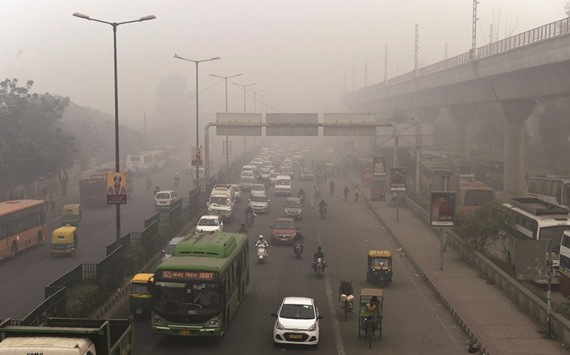Air quality in Delhi and the National Capital region deteriorated further yesterday, the toxicity level recording a new high since the October 30 Diwali night.
Air quality monitoring agencies said the pollution level will remain ‘severe’ for the next few days due to adverse climatic conditions.
According to the Central Pollution Control Board (CPCB), the Air Quality Index touched the figure of 494 yesterday, which comes under the ‘severe’ category. Its data showed that air quality at Anand Vihar was the worst in the national capital yesterday.
The index stood at 445 on Monday and 389 on Tuesday.
On Tuesday, the air quality had improved a little to ‘very poor’ category.
The System of Air Quality and Weather Forecasting and Research (SAFAR) of the Ministry of Earth Science also painted a grim picture of pollution in the capital city.
A SAFAR official said pollution level in Delhi is set to remain ‘severe’ for a few more days, due to a drop in wind speed and temperature, and increase in humidity.
“On Tuesday, the wind speed had increased to 2km per hour, which helped in the dispersion of pollutants to some extent. However, the wind speed is below 1kmph today. Wind flowing from Haryana and Punjab has stopped completely. In addition, there is considerable drop in temperature and increase in humidity. All these factors have blocked dispersal of pollutants,” said Neha Parkhi, a researcher at SAFAR.
Delhi has been witnessing low visibility due to higher concentration of pollutants hanging in the air, made worse by bursting of firecrackers during Diwali.
In addition, emissions from vehicular traffic and burning of agricultural residue in neighbouring states are adding to the pollution.
“Wind speed is zero; so is vertical wind speed. And the bursting of firecrackers, apart from pollution by vehicles and power plants, are contributory factors,” Vivek Chattopadhyay, a member of Centre for Science and Environment, said.
Interestingly, air quality in cities like Mumbai and Pune has improved significantly since Diwali due to high winds.
Yesterday, various locations across the National Capital Region showed PM2.5 and PM10 levels much above the safe limits. While PM2.5 levels ranged between 408 to over 500, PM10 levels were between 392 to over 500.
Particulate Matter less than 10 micrometres in diameter (PM10) are so small that they can get into lungs, likely causing serious health problems. Particulate Matter less than 2.5 micrometers in diameter (PM2.5) are more refined particles produced by burning fuels.

Motorists drive on a major road as smog covers New Delhi’s skyline yesterday.


